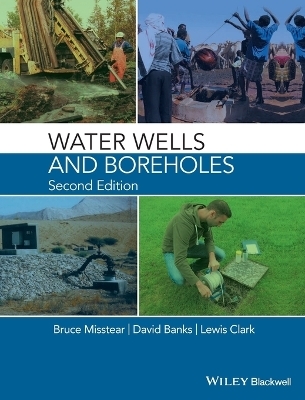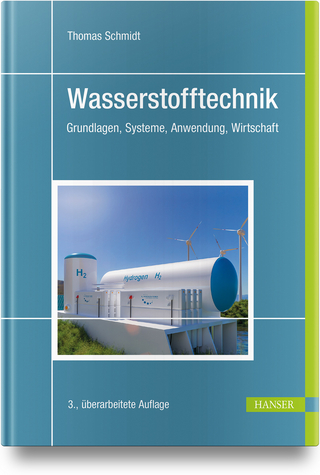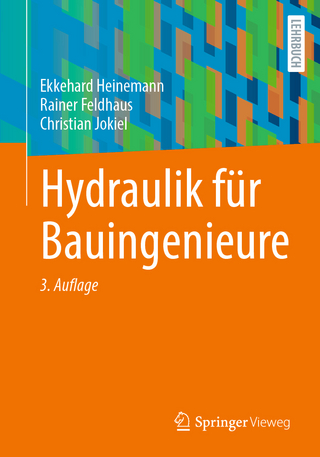
Water Wells and Boreholes
Wiley-Blackwell (Verlag)
978-1-118-95170-5 (ISBN)
Completely revised and updated throughout, Water Wells and Boreholes, Second edition, is the ideal reference for final-year undergraduate students in geology and civil engineering; graduate students in hydrogeology, civil engineering and environmental sciences; research students who use well data in their research; professionals in hydrogeology, water engineering, environmental engineering and geotechnical engineering; and aid workers and others involved in well projects.
Bruce Misstear teaches hydrogeology at Trinity College Dublin, where he is a Fellow of the College. He previously worked for an international firm of consulting engineers, carrying out groundwater development projects in many countries in Europe, Africa, the Middle East and Asia. His current research interests include groundwater pollution, aquifer recharge and groundwater engineering. David Banks is a consulting hydrogeologist with Holymoor Consultancy Ltd in the UK and is a Research Fellow at the University of Glasgow. His particular interests include mine water, hydrochemistry and ground source heat. He has worked extensively internationally in Scandinavia, Eastern Europe, Russia, Central Asia, South America and Africa. The late Lewis Clark worked for many years with the Water Research Centre in the UK before setting up his own consultancy. He was involved in many groundwater projects internationally, especially in Europe, Africa and Asia. He was also a Visiting Professor in Hydrogeology at University College London.
Preface to Second Edition x
Preface to First Edition xi
Lewis Clark (1937–2004): An Appreciation xiii
Acknowledgements xiv
1 Introduction 1
1.1 Wells and boreholes 1
1.2 Groundwater occurrence 5
1.2.1 Aquifers, aquicludes and aquitards 5
1.2.2 Porosity and aquifer storage 12
1.3 Groundwater flow 17
1.3.1 Darcy’s equation 17
1.3.2 General equations of groundwater flow 21
1.3.3 Radial flow to wells 25
2 Groundwater Investigations for Locating Well Sites 28
2.1 Desk studies 31
2.2 Field reconnaissance 35
2.3 Well survey 36
2.4 Geophysical surveys 41
2.4.1 Electrical resistivity 42
2.4.2 Electromagnetics 49
2.5 Drilling investigations 52
2.6 Groundwater resources assessment 59
2.6.1 Inflow estimation: direct recharge 61
2.6.2 Inflow estimation: indirect recharge 64
2.6.3 Aquifer response analysis 65
2.6.4 Outflow estimation 66
2.6.5 Catchment water balance and modelling 66
2.7 Groundwater quality 69
2.7.1 Introduction 69
2.7.2 Chemical composition of groundwater 69
2.7.3 Groundwater for potable supply 72
2.7.4 Groundwater for irrigation 77
2.8 Pollution risk assessment and prevention 78
2.8.1 Groundwater vulnerability 79
2.8.2 Wellhead protection areas 81
2.8.3 Estimating the pollution risk for a new well site 85
2.9 Planning the well scheme 87
3 An Introduction to Well and Borehole Design 91
3.1 Drilled wells 91
3.1.1 General design principles 91
3.1.2 Wells in crystalline aquifers 96
3.1.3 Wells in consolidated aquifers 100
3.1.4 Wells in unconsolidated aquifers 104
3.1.5 Economic considerations in well design 107
3.2 Hand‐dug wells 109
3.2.1 Design for yield 113
3.2.2 Design for health 114
3.3 Infiltration galleries 116
3.4 Radial collector wells 120
3.5 Observation boreholes 120
3.6 Exploration boreholes 125
3.7 Pump selection 125
3.7.1 Vertical turbine pumps 128
3.7.2 Electrical submersible pumps 129
3.7.3 Motorized suction pumps 133
3.7.4 Helical rotor pumps 134
3.7.5 Hand pumps 135
4 Issues in Well Design and Specialist Applications 140
4.1 Choice of construction materials 140
4.1.1 Strength 141
4.1.2 Jointing system 141
4.1.3 Durability 143
4.1.4 Chemical inertness 143
4.1.5 Standards 144
4.2 Casing 145
4.2.1 Steel casing 145
4.2.2 Plastic and fibreglass casing 146
4.3 Screen 147
4.3.1 Slot design and open area 147
4.3.2 Slot width 149
4.4 Gravel pack design 150
4.4.1 Natural gravel pack 150
4.4.2 Artificial gravel pack 151
4.5 Hydraulic design 154
4.5.1 Partial penetration effects 156
4.5.2 The damage zone and well bore skin 158
4.5.3 Gravel pack loss 159
4.5.4 Screen entrance loss 159
4.5.5 Well upflow losses 162
4.6 Economic optimization of well design 167
4.6.1 General principles 167
4.6.2 Example 168
4.7 Groundwater and wells for heating and cooling 171
4.7.1 Groundwater for cooling 172
4.7.2 Heating with groundwater: geothermal fluids 173
4.7.3 Heating with groundwater: heat pumps 174
4.7.4 Well configurations 175
4.8 Well doublets 177
4.8.1 Hydraulic equations 178
4.8.2 Feedback and breakthrough 178
4.8.3 Water chemistry 179
4.9 Recharge wells 180
4.9.1 Purpose 180
4.9.2 Construction of injection wells 182
4.9.3 Installations 183
4.9.4 Testing and operation 184
4.9.5 Clogging of recharge wells 184
4.9.6 Seismic risk from water injection 188
4.10 Aquifer storage and recovery 188
5 Well and Borehole Construction 191
5.1 Percussion (cable‐tool) drilling 193
5.1.1 Drilling in hard‐rock formations 196
5.1.2 Drilling in soft, unstable formations 198
5.1.3 Light‐percussion drilling 201
5.2 Rotary drilling 202
5.2.1 Direct circulation rotary 202
5.2.2 Fluids used in direct circulation rotary drilling 208
5.2.3 Reverse circulation 212
5.2.4 Top‐hole and down‐the‐hole hammer drilling 215
5.2.5 Dual rotary 217
5.2.6 Borehole testing during drilling 218
5.2.7 Methods of casing and screen installation 220
5.3 Sonic drilling 221
5.4 Auger drilling 222
5.5 Jetting 223
5.6 Direct push and drive sampling 224
5.7 Driving of well‐points 226
5.8 Manual construction 226
5.9 Well development 228
5.9.1 Well and aquifer damage 229
5.9.2 Developing the well 229
5.9.3 Developing the aquifer around the well 229
5.9.4 Methods of development 231
5.9.5 Disinfecting the well 240
5.10 Wellhead completion 240
6 Formation Sampling and Identification 244
6.1 Observing the drilling process 244
6.1.1 Observing the drilling process in hard‐rock aquifers 247
6.2 Collecting formation samples 248
6.2.1 Disturbed formation sampling 248
6.2.2 Undisturbed formation sampling 256
6.3 Description and analysis of drilling samples 260
6.3.1 Characterizing disturbed samples 261
6.3.2 Characterization of representative samples 261
6.3.3 Characterization of undisturbed samples 267
6.4 Downhole geophysical logging 269
6.4.1 The geophysical logging package 270
6.4.2 Organizing a geophysical logging mission 275
6.4.3 On arriving on site 275
6.4.4 Formation logs 276
6.4.5 Fluid logs 283
6.4.6 Well construction logs 287
6.5 Downhole geophysical imaging 287
6.6 Distributed (fibre‐optic) temperature sensing (DTS) 290
6.7 Preparing a composite well log 292
7 Well and Borehole Testing 295
7.1 Objectives of test pumping 295
7.1.1 Well performance 295
7.1.2 Water quality 296
7.1.3 Sustainability 296
7.1.4 Environmental impacts 298
7.1.5 Aquifer properties 298
7.2 Planning a well pumping test 298
7.2.1 Before starting 298
7.2.2 When to test pump 301
7.2.3 Consents and permissions 301
7.2.4 Equipment 302
7.2.5 The observation network 308
7.2.6 Recording of data 313
7.3 Types of pumping test 315
7.3.1 Dimension pumping 315
7.3.2 The step test 315
7.3.3 Medium to long‐term (constant rate) test 316
7.3.4 Recovery test 317
7.4 Analysis of test pumping data from single wells 317
7.4.1 Fundamentals 317
7.4.2 The misuse of test pumping analysis 318
7.4.3 Well performance – the step test 320
7.4.4 Steady-state analyses 323
7.4.5 Time‐variant analysis 326
7.4.6 Analysis of recovery tests 331
7.5 Multiple wells 334
7.5.1 Steady-state analysis of multiple pumping wells 334
7.5.2 Time‐variant analysis of multiple wells 334
7.5.3 Application of the Cooper‐ Jacob approximation to multiple wells 334
7.6 The shape of the yield‐drawdown curve: Deviations from the ideal response 335
7.6.1 A non‐infinite aquifer: Presence of an impermeable barrier 336
7.6.2 Recharge during a pumping test 336
7.6.3 Unconfined aquifers: Delayed yield 339
7.6.4 Poroelasticity, subsidence and the ‘Noordbergum Effect’ 341
7.6.5 Large diameter wells 341
7.6.6 Diagnostic plots 342
7.7 Interpretation of pumping and recovery test data in hard‐rock aquifers 344
7.7.1 High yielding hard‐rock wells 345
7.7.2 Low‐yielding hard‐rock wells 346
7.7.3 Sustainable yield of hardrock wells 348
7.8 Single borehole tests: slug tests 350
7.8.1 Slug tests 350
7.8.2 Packer testing 352
7.9 Tracer tests 353
7.10 Geophysical logging during pumping tests 355
7.11 Test pumping a major well field: the Gatehampton case study 356
7.12 Record‐keeping 359
8 Groundwater Sampling and Analysis 361
8.1 Water quality parameters and sampling objectives 363
8.1.1 Master variables 363
8.1.2 Main physicochemical parameters 363
8.1.3 Major ions 364
8.1.4 Drinking water 365
8.1.5 Water for agricultural and industrial purposes 367
8.1.6 Pollution‐related parameters 367
8.1.7 Indicator parameters 369
8.1.8 Microbiological quality and indicator parameters 370
8.2 Field determinations 373
8.2.1 The purpose of field determinations 373
8.2.2 Downhole sondes and throughflow cells 374
8.2.3 Field kits for other parameters 375
8.2.4 Emergency water supply 377
8.3 Collecting water samples from production wells 380
8.3.1 The sample line 380
8.3.2 When to sample: well testing 380
8.3.3 When to sample: production wells 382
8.4 Collecting water samples from observation boreholes 383
8.4.1 Preparation for sampling 383
8.4.2 Bailers and depth samplers 384
8.4.3 Simple pumps 386
8.4.4 Submersible pumps 386
8.4.5 Other pumps 387
8.4.6 Sampling at specific depths 389
8.4.7 Sampling for non‐aqueous phase liquids 391
8.5 Sample filtration, preservation and packaging 392
8.5.1 Sampling order 394
8.5.2 Physicochemical parameters 394
8.5.3 Microbial parameters 396
8.5.4 Inorganic parameters: acidification and filtration 397
8.5.5 Inorganic parameters: sampling 400
8.5.6 Organic parameters 400
8.5.7 Stable isotopes 403
8.5.8 Dissolved gases 404
8.6 Packing and labelling samples 406
8.7 Quality control and record keeping 407
8.8 Sample chemical analysis 408
8.9 Hydrochemical databases 412
9 Well Monitoring and Maintenance 414
9.1 Factors affecting well system performance 415
9.1.1 Physical processes 415
9.1.2 Chemical processes 416
9.1.3 Microbiological processes 421
9.1.4 Well design and construction 423
9.1.5 Well system operation 423
9.2 Monitoring well system performance 424
9.2.1 Monitoring well performance 425
9.2.2 Well inspection tools 433
9.2.3 Pump performance 434
9.2.4 Water quality monitoring 436
9.2.5 Monitoring microbial processes 436
9.3 Well maintenance and rehabilitation measures 437
9.4 Well decommissioning 443
10 Well and Borehole Records 446
10.1 Well archives 446
10.2 Operational well databases 447
10.3 An example of a hydrogeological database ‐ Afghanistan 454
Appendix 1 Units and Conversion Tables 458
Appendix 2 Hydraulic Equations for
Groundwater Engineers 460
Appendix 3 Health and Safety Plans 464
Appendix 4 World Health Organization
Drinking Water Guidelines 467
Appendix 5 FAO Irrigation Water
Quality Guidelines 473
References 475
Index 506
| Erscheinungsdatum | 19.03.2017 |
|---|---|
| Verlagsort | Hoboken |
| Sprache | englisch |
| Maße | 191 x 249 mm |
| Gewicht | 1179 g |
| Themenwelt | Naturwissenschaften ► Biologie ► Ökologie / Naturschutz |
| Naturwissenschaften ► Geowissenschaften ► Geologie | |
| Naturwissenschaften ► Geowissenschaften ► Hydrologie / Ozeanografie | |
| Technik ► Bauwesen | |
| Technik ► Umwelttechnik / Biotechnologie | |
| ISBN-10 | 1-118-95170-0 / 1118951700 |
| ISBN-13 | 978-1-118-95170-5 / 9781118951705 |
| Zustand | Neuware |
| Informationen gemäß Produktsicherheitsverordnung (GPSR) | |
| Haben Sie eine Frage zum Produkt? |
aus dem Bereich


